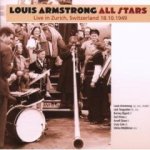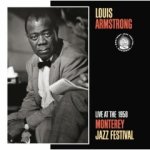Home » Jazz Articles » Bailey's Bundles » Back to the Roots with Louis Armstrong
Back to the Roots with Louis Armstrong
Live In Zurich, Switzerland 18.10.1949 and Live At The 1958 Monterey Jazz Festival were recorded 20 and 30 years after Armstrong began recording his famous Hot Fives and Hot Sevens sides. He had graduated to the Gravy Circuit, playing the music he made famous with no ambition of plowing new fields or defining new genres. Leave that stuff to descendent Miles Davis.
The music on these albums sounds vital in its sepia-toned splendor, anticipating swing and be-bop. Hipper, more contemporary music was being made and recorded at the same time as these performances, but none of that hipper, more contemporary music would have been possible had Armstrong not made this music first.
 Louis Armstrong All Stars
Louis Armstrong All Stars
Live In Zurich, Switzerland 18.10.1949
The Montreaux Jazz Label
2007
There are a couple of things really endorsing this performance. The first is that Armstrong surrounds himself with a bunch of certified old timers like himself, including trombonist Jack Teagarden, pianist Earl Hines, drummer Cozy Cole, clarinetist Barney Bigard, bassist Arvell Shaw, and singer Velma Middleton.
The second is the fact that this performance is closer to Armstrong's salad days, before he became an American arts "ambassador." This in no way impugns the validity of the later Monterey performance; that is historic in its own right, 1958 being the inaugural festival (with this year the Golden Anniversary).
The listener need only cue up track three and hear Jack Teagarden kick off a boozy "Basin Street Blues" to understand the friendliness of the music that Teagarden and Armstrong were so instrumental in helping develop. Armstrong's brief break, before Teagarden tailgates his way through a chorus and his own solo afterward, shows the trumpeter as the seminal jazz force he was, inventive and always smiling. The instrumentalS "Royal Garden Blues" and "Struttin' With Some Barbeque" further demonstrate Armstrong's seriousness about the music.
Perhaps the best performances on the disc are Armstrong's total triumph, vocally and instrumentally on "Black and Blue" and Earl Hines' feature on the rocking "Fine and Dandy." Armstrong shows why he has influenced every jazz vocalist after him on the former, and Hines details all of piano history before—and some of after—on the latter.
This is genuine New Orleans jazz played in the rough and tumble manner of the 1930s, but a decade later. Armstrong's Swiss audience sounds large and appreciative, indicating that Armstrong indeed was an effective ambassador. Louis Armstrong
Louis Armstrong
Live At The 1958 Monterey Jazz Festival
Monterey Jazz Festival Records
2007
Almost a decade later, when Armstrong appeared at the first Monterey Jazz Festival, he was received as royalty, introduced appropriately by John Birks Gillespie. The only hold over from his Zurich band is vocalist Velma Middleton. His theme to open the show is the same as before, "When It's Sleepy Time Down South." The remainder of the repertoire reflects the ten years that passed since the 1949 Swiss performance.
Armstrong sprinkles Fats Domino's "Blueberry Hill," Juan Tizol's "Perdido," and Kurt Weill's "Mack The Knife" among the Dixieland standards "Indiana," "Tiger Rag," and "Bucket's Got A Hole In It." There is plenty of Armstrong horn, but much more Armstrong singing than on the Zurich recording. Armstrong also digs into the American songbook, pulling out chestnuts such as "Autumn Leaves," "After You've Gone," and "These Foolish Things."
By the late 1950s, Armstrong had fully taken on his ambassador roll. He was still performing at a very high level and still had a cracking horn. When a listening public might have expected Armstrong to rest on his laurels and coast through these performances, Armstrong thought otherwise, electing to maintain his standard of grace and hipness, always professional.
These recordings are important as they are previously unreleased live performances by one of the handful of the greatest innovators in not just jazz, but all of American music. This is jazz that is okay to smile with.
Tracks and Personnel
Live In Zurich, Switzerland 18.10.1949
Tracks: When It's Sleepy Time Down South; That's A Plenty; Basin Street Blues; Royal Garden Blues; Struttin' With Some Barbeque; Black And Blue; Velma's Blues; Honey Suckle Rose; Fine And Dandy; Body And Soul; Back O'Town Blues; High Society; Do You Know What It Means; The Huckle-Buck.
Personnel: Louis Armstrong: vocals, trumpet; Jack Teagarden: vocals, trombone; Velma Middleton: vocals; Barney Bigard: clarinet; Earl Hines: piano; Arvell Shaw: bass; Cozy Cole: drums.
Live At The 1958 Monterey Jazz Festival
Tracks: Introduction by Dizzy Gillespie; When It's Sleepy Time Down South; (Back Home Again In) Indiana; Blueberry Hill; Tiger Rag; Now You Has Jazz; High Society Calypso; Bucket's Got A Hole In It; Perdido; Autumn Leaves; After You've Gone; These Foolish Things; Mack The Knife; Stompin' At The Savoy; Undecided; St. Louis Blues; That's My Desire; When The Saints Go Marching In.
Personnel: Louis Armstrong: vocals, trumpet; Trummy Young: trombone, vocals; Peanuts Hucko: clarinet; Billy Kyle: piano; Mort Herbert: Bass; Danny Barcelona: drums; Velma Middleton: vocals.
< Previous
Regina Carter: Experimenting with Time
Next >
Force of Light
Comments
About Louis Armstrong
Instrument: Trumpet and vocals
Related Articles | Albums | Photos | Similar ToTags
For the Love of Jazz
 All About Jazz has been a pillar of jazz since 1995, championing it as an art form and, more importantly, supporting the musicians who create it. Our enduring commitment has made "AAJ" one of the most culturally important websites of its kind, read by hundreds of thousands of fans, musicians and industry figures every month.
All About Jazz has been a pillar of jazz since 1995, championing it as an art form and, more importantly, supporting the musicians who create it. Our enduring commitment has made "AAJ" one of the most culturally important websites of its kind, read by hundreds of thousands of fans, musicians and industry figures every month.



















